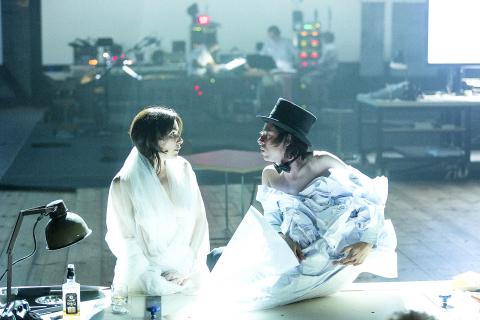Dutch national theater company Toneelgroep Amsterdam (TGA) is returning to Taipei this weekend after a two-year hiatus to close the Taipei International Arts Festival.
The troupe, led by its avant-garde artistic director Ivo van Hove, is to perform its thought-provoking, four-hour-long production adapted by Koen Tachelet from the novel The Fountainhead by controversial American author and philosopher Ayn Rand.
A play containing grand ideas about society and the relationship between the individual and the collective, the story follows Howard Roark, played by poet, actor and former Dutch “poet of the fatherland” Ramsey Nasr, who for this production learned to sketch architectural designs in the style of US architect Frank Lloyd Wright.

Photo courtesy of Jan Versweyveld and TGA
An ambitious and virtuous architect, Roark is willing to bear the ultimate sacrifice for his ideas: To forgo friendship and love, to be rejected by society and, ultimately, to destroy his own creation for the integrity of his architectural ideal.
This lonely process acquires another dimension when the protagonist meets Dominique Francon, powerfully played by lead actress Halina Reijn, who manifests herself as a kindred spirit as well as a formidable opponent in a relationship that is alternately creative and destructive — and which receives much attention in this stage rendering.
Since her breakthrough with The Fountainhead in 1943, Rand and her following have been a force to reckon with, where the author — who preached a philosophy of extreme rational self-interest dubbed Objectivism and reportedly features prominently on the reading shelves of US President Donald Trump and Speaker of the House of Representatives Paul Ryan — is in equal measures admired and reviled.
However, no such politically laden history of controversy exists in the Netherlands, where TGA staged the novel, which is not as widely read in Europe, but has inspired generations of architects and artists.
This has allowed the director to approach the material with fresh eyes, resulting in a play that conveys the full emotional depth of the story, but does not eschew giving Rand’s ideas full stage, whether through archetypal characters that personify the ideas at war in the story or a powerfully rendered double monologue that receives full stage, a flourish that, contrary to the novelist’s original, gives equal voice to both sides of the ethical dilemma facing the architect.
Dutch daily NRC Handelsblad said Van Hove has managed to keep a precariously balanced perspective, “cautiously guiding Rand past the abyss of her own ideology.”
The production is designed by Jan Versweyveld, who has cooperated with Van Hove on a series of high profile plays in recent years. While grand-scale designs do not always benefit a play’s intimacy, Versweyveld’s visually rich multimedia approach and spectacular stage are ideally suited to a story that combines ideas, intrigue and architectural design.
Live music is performed onstage and scenes are projected on a large screen, allowing the audience to follow the process of architectural creation.
The play is performed in Dutch, with English and Chinese surtitles, runs for four hours with an intermission and includes “adult content” — nudity, smoking and blood scenes.
Pre-talks are held 30 minutes before every performance in the theater’s lobby, with a post-show talk after the matinee on Sunday.

Most heroes are remembered for the battles they fought. Taiwan’s Black Bat Squadron is remembered for flying into Chinese airspace 838 times between 1953 and 1967, and for the 148 men whose sacrifice bought the intelligence that kept Taiwan secure. Two-thirds of the squadron died carrying out missions most people wouldn’t learn about for another 40 years. The squadron lost 15 aircraft and 148 crew members over those 14 years, making it the deadliest unit in Taiwan’s military history by casualty rate. They flew at night, often at low altitudes, straight into some of the most heavily defended airspace in Asia.

Beijing’s ironic, abusive tantrums aimed at Japan since Japanese Prime Minister Sanae Takaichi publicly stated that a Taiwan contingency would be an existential crisis for Japan, have revealed for all the world to see that the People’s Republic of China (PRC) lusts after Okinawa. We all owe Takaichi a debt of thanks for getting the PRC to make that public. The PRC and its netizens, taking their cue from the Chinese Communist Party (CCP), are presenting Okinawa by mirroring the claims about Taiwan. Official PRC propaganda organs began to wax lyrical about Okinawa’s “unsettled status” beginning last month. A Global

Taiwan’s democracy is at risk. Be very alarmed. This is not a drill. The current constitutional crisis progressed slowly, then suddenly. Political tensions, partisan hostility and emotions are all running high right when cool heads and calm negotiation are most needed. Oxford defines brinkmanship as: “The art or practice of pursuing a dangerous policy to the limits of safety before stopping, especially in politics.” It says the term comes from a quote from a 1956 Cold War interview with then-American Secretary of State John Foster Dulles, when he said: ‘The ability to get to the verge without getting into the war is

Like much in the world today, theater has experienced major disruptions over the six years since COVID-19. The pandemic, the war in Ukraine and social media have created a new normal of geopolitical and information uncertainty, and the performing arts are not immune to these effects. “Ten years ago people wanted to come to the theater to engage with important issues, but now the Internet allows them to engage with those issues powerfully and immediately,” said Faith Tan, programming director of the Esplanade in Singapore, speaking last week in Japan. “One reaction to unpredictability has been a renewed emphasis on